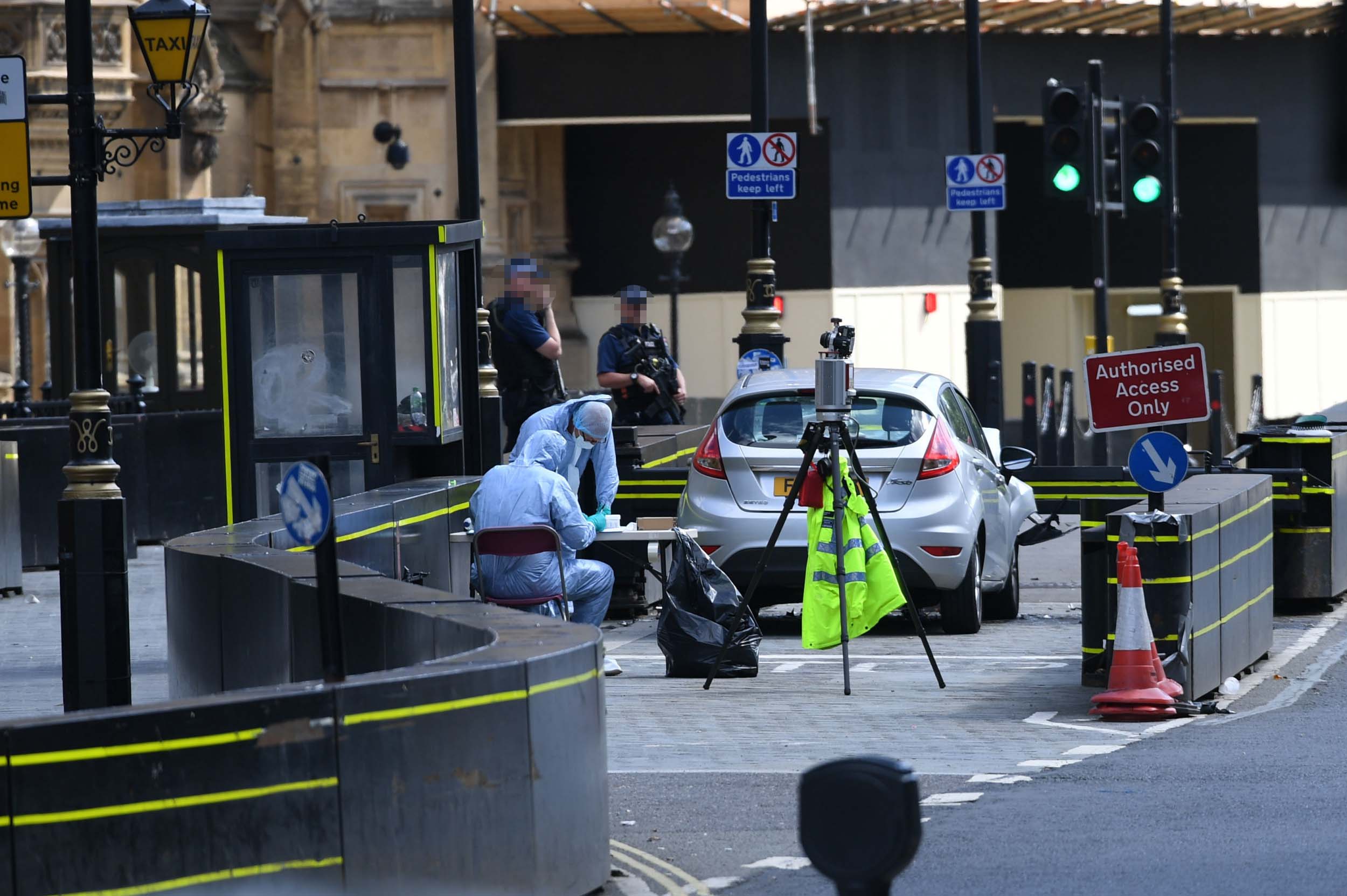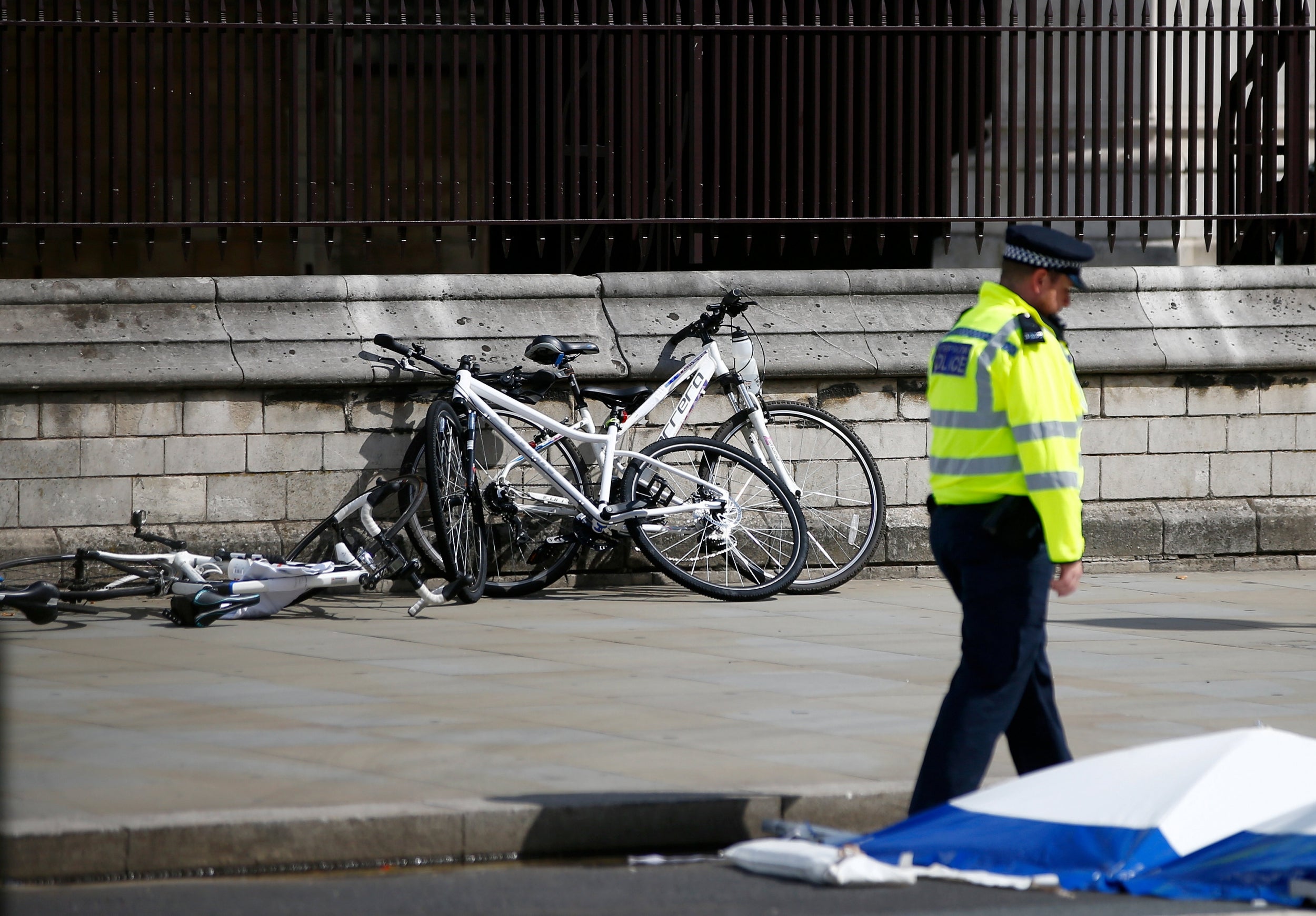Parliament car crash is sixth attempted terror attack targeting Westminster in 17 months
'Westminster and what it stands for – our values, our tolerance, our liberal society – is always going to be a target,' security minister says

A vehicle attack that injured three people in Westminster is the latest in a long line of attempted atrocities targeting the political heart of the UK.
The car struck metres away from where Khalid Masood stabbed a police officer to death outside the Houses of Parliament after ploughing his a car into pedestrians on Westminster Bridge in March 2017.
That was the first massacre claimed by Isis in Britain, and was swiftly followed by four other terror attacks, including two – one Isis-inspired and one far-right – that used vehicles as a weapon.
As the terrorist group’s methodology has spread around the world, Westminster has emerged as one of the most common targets for fanatics in the UK.
Of the 13 Islamist terror plots foiled since the first Westminster attack, at least four have targeted the same area.
Last month Khalid Ali, a former Taliban bombmaker, was jailed for life after being arrested walking towards parliament armed with three knives in April 2017.
Later the same day, police arrested members of Britain’s first all-female jihadi cell, who had been planning a knife attack in Westminster.
It was also among the attack locations listed by another Isis fanatic, Umar Haque, who was arrested in May 2017 for training an “army of children” to launch simultaneous atrocities in London.

Then in November, another jihadi was caught with what he believed to be a bomb and suicide vest to use in Downing Street.
Naa’imur Zakariyah Rahman planned to bomb the gates protecting the prime minister’s official residence before storming the building in a suicide vest to behead the prime minister.
Praising Masood’s attack in its English-language propaganda magazine, Isis called London the “heart of Crusader territory” and hailed the deaths of “disbelievers” and police – who may have been the target of the latest attempt.
Raffaello Pantucci, director of International Security Studies at the Royal United Services Institute (Rusi), said Westminster was a significant target as the “political heart of the UK”.
“If you’re trying to make a political statement for a terrorist organisation, this is the place where you’re visibly striking at the government,” he told The Independent.
“It’s very clearly going to have an impact: it’s a guaranteed way of making sure you get attention that you might not get if you did it somewhere else.”
Ben Wallace, the security minister, said the government had started a fresh review of security around the Houses of Parliament following the introduction of new security barriers and changed police protocols after the first Westminster attack.
“I’m afraid that the Palace of Westminster and what it stands for – our values, our tolerance, our liberal society – is always going to be a target for those people whose beliefs we directly challenge,” he added.
“That’s why we’ve seen attacks here against us, either previous plots or actual attacks carried out.
“Iconic symbols are often what terrorists go for and if they can’t go for the police and the armed forces directly, they will choose to go where our values are symbolised.”
Mr Wallace said the government was carrying out a new “scoping exercise” to protect the Houses of Parliament but warned that terrorists were “very good at exploiting our vulnerabilities”.
“The investment parliament has put in over the years has certainly made it harder for them,” he added.
Theresa May said Westminster was the home of British democracy and “a potent symbol for our precious values of tolerance and freedom”.
“The twisted aim of the extremists is to use violence and terror to divide us,” she added. “They will never succeed.”
Police were working to establish the precise motive of the suspect, who is a 29-year-old British citizen from the Midlands, while searching two properties in Birmingham and one in Nottingham.
Investigators said the silver Ford Fiesta used in the attack had been driven from Birmingham to London late on Monday night, arriving in the capital just after midnight.
It was in Tottenham Court Road area from 1.25am until 5.55am, then Westminster and Whitehall area from approximately 6am until the crash shortly after 7.30am.
It came during parliament’s summer recess and ahead of the daily rush of tourists to the area, leaving the area relatively deserted of potential targets apart from a group of police officers guarding the security barriers, who leapt out of the way and narrowly avoided being hit by the car.
Three people were injured in the attack, including a woman who remains in hospital with serious injuries.

Security services are foiling terror plots once a month on average, and Britain had the highest number of attempted or successful attacks in the EU in 2017.
The national terror threat level in the UK is “severe”, meaning further attacks are considered “highly likely”.
Security services have spoken of the “unprecedented” scale of the current threat, as the rise of low-tech knife and vehicle attacks make preparations faster and harder to intercept than past bombings associated with al-Qaeda and the IRA.
While losing territory in Syria and Iraq, Isis has placed increasing emphasis on calls for its followers to carry out atrocities on home soil.
As well as naming shopping streets, concerts and crowded areas among potential targets, it has issued detailed advice on carrying out vehicle and knife attacks of the kind seen across Europe.
Mr Pantucci said the group had made atrocities “very easy to do and very accessible”.
“The difficulty is that once you have a new methodology used, you will see other types of extremist use it as well,” he added.
“It means people will say ‘I don’t need to build a bomb or get a gun, I can just drive into a crowd’.”
He said British security services had started disrupting plots earlier, using online material and communications to prove attack planning.
Following the latest incident on Tuesday, the prime minister’s spokesperson said 13 Islamist and four far-right plots have been foiled since the first Westminster attack.
A total of 676 terrorism investigations by MI5 and counterterrorism police were under way by the end of June this year, up from around 500 just four months before.
A record number of terror-related arrests are being made in the UK, with Islamist extremists making up the majority of terrorist prisoners followed by the extreme right.
